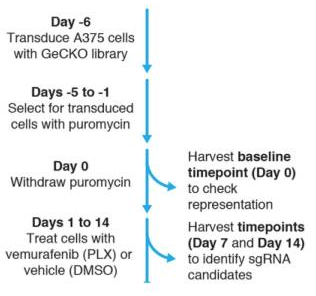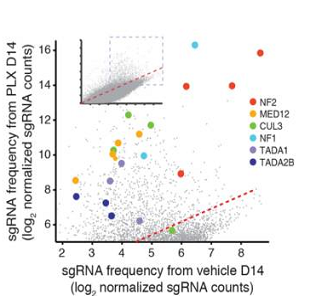CRISPR technology has become one of the most effective method for gene/genome editing. CRISPR libraries / sgRNA libraries can simultaneously edit multiple genes in a signal pathway or an entire genome, which is a powerful research tool in CRISPR screening. Through functional screening and enrichment, PCR amplification, and deep sequencing analysis, the functional gene can be identified and the related signal pathway and molecular mechanism can be recognized. This technology has been widely used in cancer diagnosis, drug discovery, etc.
Synbio Technologies has accumulated more than ten years of CRISPR library experience. We provide customers around the world with precise, efficient, and customized solutions, including sgRNA design, oligo pool synthesis, CRISPR library/sgRNA library construction, NGS validation, and high-content screening.
CRISPR Library/sgRNA Library Process

CRISPR Library/sgRNA Library Construction and Screening Workflow

Competitive Advantages
- Proprietary algorithm enables precision editing with minimal off-target.
- One stop solution from genome wide sgRNA design to library construction.
- Wide experience ensures building up any type of library for any species.
- Express delivery of transfection grade plasmids with high QC standard.
- Reliable partnership in bio-industry for a decade.
Service Specifications
| Service Specifications | Service Steps | Turnaround Time |
|---|---|---|
| sgRNA Design | sgRNA sequences are designed for specific genes. Each gene will be designed with 3-6 sgRNAs. |
1-2 weeks |
| Oligo Pool Synthesis | All designed sgRNAs and negative controls will be synthesized on one chip | 3-4 weeks |
| sgRNA Library Construction | Cloning these sgRNAs on the target vector | 2-3 weeks |
| Plasmid Purification | Transfection-grade plasmid preparation to meet the shipping need | 1 week |
| Library Quality Evaluation&NGS Verification(Optional) |
|
2-3 weeks |
| Total | 9-13 weeks |
CRISPR Library/sgRNA Library Screening Case Study
Screening resistance targets for a drug with identified function
Methods
- The function and lethal dose of the drug have been already identified.
- CRISPR library was synthesized and transfected into cells using lentivirus.
- Screening: drug of high concentration acting on the mixed cell clone continuously over a short period, then screening the survived cells. These cells are considered to be resistant to this drug. The reason why these cells gain a resistance to this drug is due to mutagenesis caused by CRISPR-Cas9 gRNA.
- Perform NGS and bioinformatics analysis on the surviving cells, analyze information about the gRNA, and then identify the genes involved in conferring drug resistance.


Results
- Identification of 6 genes involved in PLX resistant when mutant
- Identification of NF2 as the resistant target of PLX in melanoma

